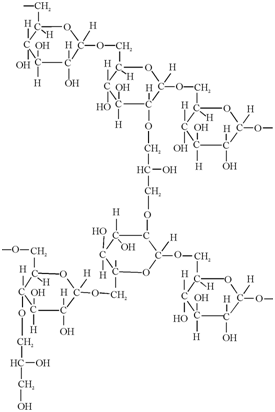Dextran gels (Sephadex):
Dextran is a polysaccharide, built up from glucose residues. It is produced from the fermentation of sucrose. The micro-organism which is used for fermentation is Leuconostoc mesenteroides strain NRRLB512. The native dextran has high molecular mass and a wide mass distribution (10 - 300) × 106. The raw material is purified, partly hydrolysed and finally fractionated by ethanol precipitation to give a product of suitable average mass and a narrow mass distribution. The glucose residues are joined by α-1, 6-glucosidic linkages. The chains are to a certain extent branched. The branches are joined to the main chain by 1-2, 1-3 or 1-4 glucosidic linkages. If we prepare dextran by Leuconostoc mesenteriodes strain B512, the branches are joined through 1-3-glucosidic linkages. Dextran dissolves within water but while it is cross linked to form the gel, the polysaccharide chains of the gel form a three dimensional network. The material, thus, becomes insoluble in water.
Sephadex is manufactured by a bead polymerization process. In this process, an alkaline solution of dextran of suitable molecular mass distribution is suspended in an organic solvent which is immiscible with water. Stabilizers are added to stabilize the suspension. When the suspension is stirred to form an emulsion epichlorohydrin, reacts with dextran matrix forming glyceryl links between the chains. The product is washed thoroughly and allowed to shrink in water-alcohol mixture and then dried after the completion of the reaction. A partial structure of Sephadex is shown in Figure.

Figure: A schematic representation of partial structure of Sephadex